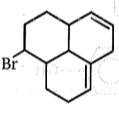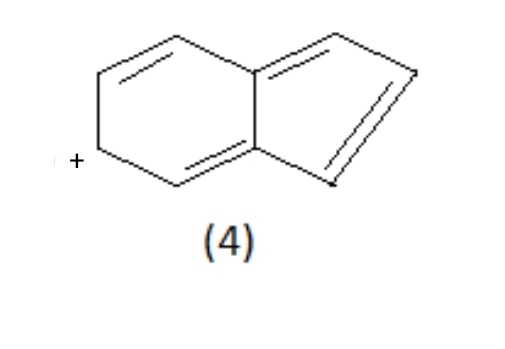Major product obtained in given reaction is:

दी गई अभिक्रिया में प्राप्त मुख्य उत्पाद क्या है?



Which reagent distinguish propyne and propene?
1. Alkaline
2. +
3. water
4. +
कौन सा अभिकर्मक प्रोपाइन और प्रोपीन को विभेदित करता है?
1. क्षारीय
2. +
3. जल
4. +
Xylene on oxidation with acidic gives:
1. phthalic acid 2. isophthalic acid
3. terephthalic acid 4. all of these
जाइलीन अम्लीय के साथ ऑक्सीकरण पर क्या देती है?
1. फ्थैलिक अम्ल 2. आइसोफ्थैलिक अम्ल
3. टेरेफ्थैलिक अम्ल 4. ये सभी

The product "A" formed is?
1. 
3. 

निर्मित उत्पाद "A" है?
1. 
3. 
Which of the following bromides is the major product of the reaction shown below, assuming that there are no carbocation rearrangement?
(1 equivalent)
1.
3.
नीचे दिखाए निम्नलिखित ब्रोमाइड में से कौन सा अभिक्रिया का प्रमुख उत्पाद है, यह मानते हुए कि कोई कार्बधनायन पुनर्व्यवस्था नहीं है?
(1तुल्यांक )
1.
3.
2, 3-dimethyl-2-butene can be prepared by heating which of the following compounds
with a strong acid?
1. 
2. (CH3)3C-CH=CH2
3. (CH3)2C=CH-CH2-CH3
4. (CH3)2CH-CH2-CH=CH2
2, 3-डाइमेथिल-2-ब्यूटीन को एक प्रबल अम्ल के साथ निम्नलिखित में से किस यौगिक को गर्म करके निर्मित किया जा सकता है?
(b) (CH3)3C-CH=CH2
(c) (CH3)2C=CH-CH2-CH3
(d) (CH3)2CH-CH2-CH=CH2
Which one of the following compounds gives acetone (CH3)2C=O as one of the product of
(a)


निम्नलिखित में से कौन सा यौगिक एसीटोन (CH3)2C=O को उत्पाद के रूप में देता है:
(a)


(Kolbe electrolysis method)
Product (A) of the reaction is :
1. CH3-CH3
2. CH2=CH2
3. CH3-CH=CH2
4. none of these
 (कोल्बे की विद्युत् अपघटनी विधि)
(कोल्बे की विद्युत् अपघटनी विधि)
अभिक्रिया का उत्पाद (A) क्या है?
1. CH3-CH3
2. CH2=CH2
3. CH3-CH=CH2
4. इनमें से कोई नहीं
A compound is treated with NaNH2 to give sodium salt. Identify the compound.
1. C2H2 2. C6H6
3. C2H6 4. C2H4
सोडियम लवण देने के लिए एक यौगिक को NaNH2 के साथ उपचारित किया जाता है। यौगिक की पहचान कीजिए।
1. C2H2 2. C6H6
3. C2H6 4. C2H4
Which of the following molecules/species are aromatic in character?



(a) 2 (b) 3
(c) 4 (d) 1
निम्नलिखित में से कौन सा अणु/स्पीशीज लक्षण में एरोमैटिक है?

(a) 2 (b) 3
(c) 4 (d) 1











